
How to Use Content to Grow Leads: 12 Killer Tips for Marketers
Are you ready for a surge in B2B lead conversions and skyrocket your business growth?
Well, utilizing content marketing is the secret sauce to fuel your success.
However, it's not just about throwing money at it. It’s about implementing the right strategies to capture and convert those valuable leads.
And with content marketing generating more than two-thirds of leads, it's a powerhouse for attracting potential customers.
But here's the thing: content marketing isn't a one-size-fits-all approach. It requires a well-crafted strategy to make the magic happen. Otherwise:
Your journey from brand awareness to conversion can take weeks or even months – without the right tactics.
In addition, you may struggle with content that fails to deliver a Return on Investment (ROI) – leaving you with minimal/non-measurable business outcomes.
Also, you might face a shortage of Marketing Qualified Leads (MQLs). As such, you will only have a limited pool of prospects – ready to progress through the sales funnel.
Finally, credibility issues arise when you neglect to establish trust and authority through your content.
When you adopt a well-crafted strategy, you can maximize ROI by aligning content with your business goals. Plus, you can target audience needs via optimized distribution channels, leading to increased MQLs and credibility.
Hence, it’s no surprise that 92% of B2B marketers consider a well-executed content plan their most valuable marketing asset.
So, let's dive deeper into why you must focus on action-oriented strategies while creating and sharing content. Moreover, let’s explore the best ways to leverage it in your business blueprint.
Utilizing Content to Grow Leads: 12 Sureshot Tips to Drive B2B Growth Like a Pro
Think about it:

The numbers don't lie.
As such, by tailoring your B2B content marketing strategy to your audience and goals, you can:
- Ignite buyer interest
- Nurture leads
- Drive conversions
After all, each buyer persona deserves its piece of the content puzzle – designed to resonate at every stage of the buyer's journey.
So, are you ready to discover how you can go about utilizing content to grow leads? Let's help you supercharge your marketing efforts and unlock those coveted leads!
1. Develop a Buyer-Centric Content Strategy
By putting your target audience at the center of your content efforts, you can effectively engage and resonate with them. As a result, you’ll ultimately drive conversions and business growth.
So, how can you implement such a strategy? Let's explore two key steps:
- Leveraging the Jobs-to-be-Done (JTBD) framework
- Conducting thorough market research
Deploy the JTBD Framework
The JTBD Framework provides a customer-centric perspective. It prioritizes the underlying motivations and goals that drive customers' purchasing decisions. Let’s check out how:
| Steps | Description |
| 1. Identify the Job | Determine the specific job or task that customers are trying to accomplish. |
| 2. Define the Outcome | Identify the desired outcome or result that customers seek when performing the job. |
| 3. Uncover Pain Points | Identify the challenges, frustrations, and obstacles that customers encounter while trying to complete the job. |
| 4. Seek Solutions | Explore the various solutions and alternatives customers consider or use to address their needs. |
| 5. Develop a Value Proposition | Create a value proposition that aligns with customers' desired outcomes and effectively addresses their pain points. |
| 6. Test and Iterate | Continuously test and refine your value proposition and offerings based on customer feedback, data, and insights. |
As you can see, this framework helps you better understand the job that your customers are trying to get done. Thus, you can align your offerings and messaging accordingly. Plus, you can better meet their needs and create content that resonates with your leads.
Conduct Market Research
Market research enables you to gain insights into the existing content landscape within your industry. Here’s how:
- Analyze the content your competitors are producing and identify gaps you can fill.
- Look for untapped opportunities and emerging trends that align with your target audience's interests.
Understanding what content is lacking or underserved allows you to position your brand as a go-to source for valuable and unique information.
Seizing Differentiation: Addressing Content Gaps
By identifying content gaps, you can differentiate your brand and stand out. Fill these gaps by creating content that:
- Provides in-depth insights
- Tackles overlooked topics
- Offers a fresh perspective
You become a trusted authority and go-to resource by addressing audience needs (not adequately met by existing content). Hence, this differentiation allows you to attract and retain your audience's attention – establishing your brand as a valuable industry leader.
2. Create Compelling Lead Magnets
Did you know offering a lead magnet can significantly increase your lead generation efforts? In fact, 50% of marketers who start using lead magnets report higher conversion rates.
By providing valuable resources, you can achieve the following:
- Entice prospects to share their contact information
- Nudge leads to initiate a relationship with your brand
For example, suppose you're a marketing agency targeting small businesses. Then, you could create a comprehensive guide on effective social media strategies tailored specifically for small businesses.
Remember that your prospects seek valuable information to help them solve their challenges and achieve their goals. In fact, B2B buyers may willingly exchange their contact information for relevant and educational content.
So, ensure your lead magnets stand out by providing:
- Exclusive industry insights
- Practical tips
- Actionable steps
–that your audience can implement immediately.
For instance, let’s assume you're a software company targeting developers. In that case, you could create a toolkit including code snippets, best practices, and resources to help them streamline their workflow.
Now, to write engaging and persuasive content for your lead magnets, consider these tips and best practices:
- First, understand which lead magnets will work best for your business.

- Use attention-grabbing headlines to pique curiosity and compel prospects to download your lead magnet.
- Start with a captivating hook that highlights the benefits and value your lead magnet offers.
- Break your content into scannable sections using subheadings, bullet points, and numbered lists to make it easy to consume.
- Incorporate relevant statistics, case studies, or customer success stories to build credibility and demonstrate the effectiveness of your solutions.
- Include a clear Call-to-Action (CTA) that directs prospects to take the next step in their buyer's journey – signing up for a demo or contacting your sales team.
3. Implement Account-Based Marketing (ABM) Tactics
By implementing ABM, you can focus on the accounts that matter most to your business. In fact,
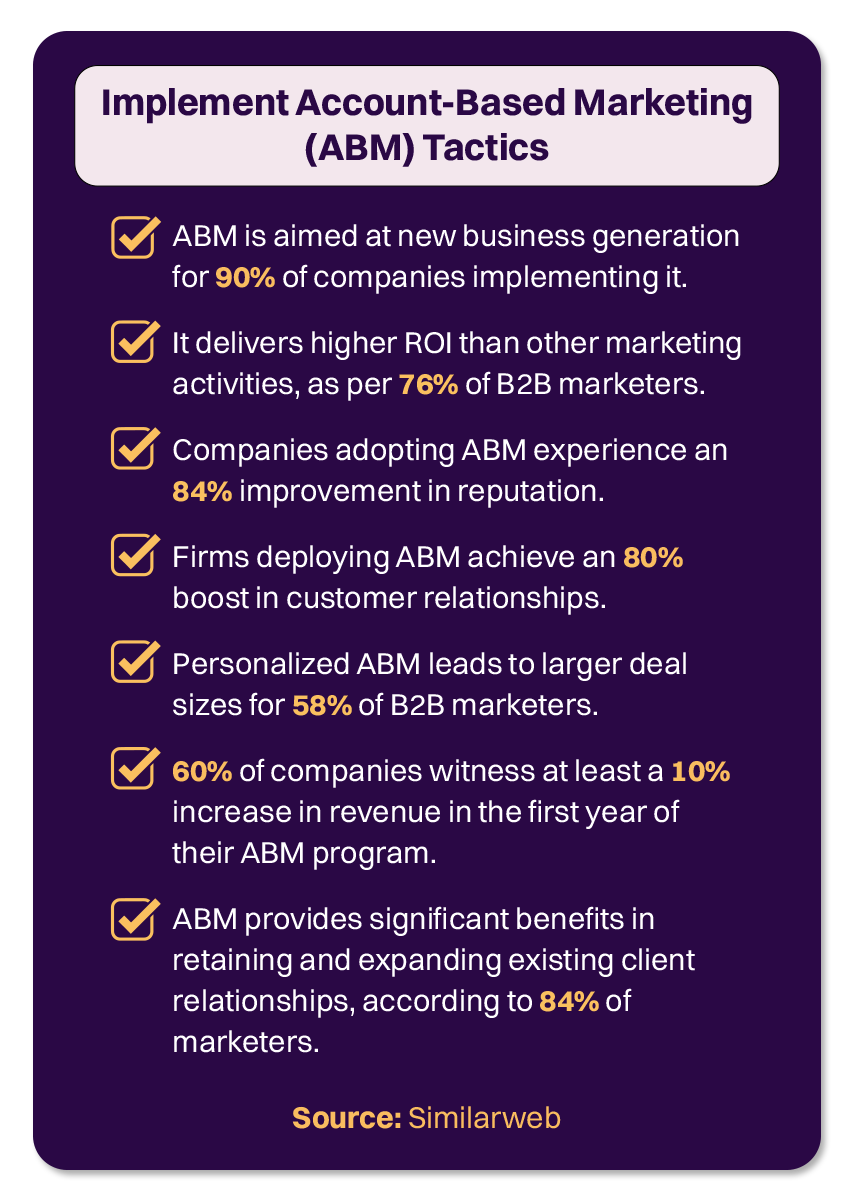
Yes, ABM strategies have proven to be highly effective in the following aspects:
- Driving revenue growth
- Maximizing the value of your target accounts
By understanding each account's unique challenges and goals, you can create content that speaks directly to their needs – increasing the chances of engagement and conversion.
Customize Your Content for Stakeholders in Targeted Accounts
In B2B sales cycles, multiple decision-makers and stakeholders are involved. So, customize your content based on their roles, responsibilities, and pain points – to effectively engage and influence them.
By tailoring your messaging and content to address their specific concerns and interests, you can increase the likelihood of buy-in and decision-making within the target accounts.
4. Optimize Landing Pages for Conversion
Did you know that landing pages with multiple offers can decrease conversion rates by 266%? In fact, focusing on a single content offer per landing page can significantly improve conversion rates.
By creating dedicated landing pages tailored to each specific content offer, you can provide a clear, focused message that resonates with your audience. Therefore,
- Use persuasive copywriting
- Embed compelling visuals
- Offer an intuitive user experience
– to guide visitors toward taking the desired action.
Incorporate Lead Capture Forms Strategically
Gathering information from your leads is essential for effective lead nurturing and personalized communication. Lead capture forms help you acquire the necessary details. However, keep your documents concise to minimize friction.
So, consider implementing progressive profiling techniques. They involve gradually collecting additional information from leads across multiple interactions.
As such, you can build comprehensive lead profiles over time – enabling personalized and targeted engagement.
Now, to optimize your content for lead generation and increase conversions, consider the following strategies:
- Add clear and compelling CTAs that prompt visitors to take the desired action, such as:
- Download Our Whitepaper
- Sign Up For Our Webinar
- Create well-designed landing pages that:
- Align with your brand
- Have a strong headline
- Contain engaging visuals
- Showcase a clear value proposition
- Optimize your lead capture forms by balancing the amount of information you request and the perceived value of the content offered.
- Utilize lead nurturing techniques to move leads through the sales funnel. For example, you can use personalized email campaigns and targeted content based on their interests and actions.
- Implement lead scoring methodologies to prioritize and segment leads based on their level of engagement and readiness to make a purchase.
- Test and improve your content optimization strategies through:
- A/B testing
- Feedback surveys
- Heat maps
- Other analytical tools
– to identify areas for enhancement and better understand user behavior.
5. Deploy The Social Selling Matrix
The Social Selling Matrix provides a systematic approach to leveraging social media platforms for utilizing content to grow leads. It offers a framework for identifying and engaging with relevant prospects through platforms like LinkedIn, Twitter, and Industry-specific forums.
By strategically using social media as a lead generation channel, you can tap into a vast pool of potential customers and build valuable relationships.
The matrix consists of four key components that guide your outbound content strategy on social media:
Identify Target Prospects
In this stage, you define your target audience or Ideal Customer Profile (ICP). Understanding ICP allows you to focus on the right individuals/companies most likely to be interested in your products or services.
Consider factors such as:
- Industry
- Job title
- Company size
- Geographic location
–to narrow down your target prospects.
Engage and Connect
Once you have identified your target prospects, it's time to engage with them on social media platforms. You can achieve the same by following the below steps:
- Actively participate in relevant discussions
- Share valuable content
- Provide insights or solutions to their pain points
Building rapport and establishing credibility through meaningful interactions is crucial to gaining their attention and trust.
Nurture Relationships
After connecting with prospects, nurturing those relationships is vital. Provide consistent value by sharing:
- Educational content
- Industry insights
- Updates about your products or services
Also, tailor your content to address the specific challenges or interests of your prospects. By staying engaged and demonstrating your expertise, you can build trust and position yourself as a reliable resource.
Convert and Measure
As relationships develop, it's time to move prospects through the sales pipeline. Direct them towards conversion actions such as:
- Downloading gated content
- Requesting a demo
- Scheduling a consultation
Track and measure the effectiveness of your social selling efforts using Key Performance Indicators (KPIs) such as:
- CTAs
- Conversion rates
- The number of qualified leads generated
This data will help you refine your strategy and optimize your social selling activities.
Illustration
Let’s consider a hypothetical company XYZ – operating in the ed-tech sphere. Here’s how it can use the Social Selling Matrix:
| Stage | Key Activities |
| Identify Target Prospects | Define the target audience as educators and administrators in K-12 schools and higher education institutions |
| Engage and Connect | Participate in LinkedIn groups for educators, share informative blog posts on Twitter, and engage in relevant forums |
| Nurture Relationships | Provide valuable content on educational technology trends, personalized learning, and student assessment through posts and articles |
| Convert and Measure | Offer free webinars on XYZ's software solutions, track webinar registrations and conversions to trial or product purchase |
6. Embrace Video Content Marketing
Video content has become an essential tool for B2B marketers to engage their target audience and drive lead generation.
It includes producing high-quality videos showcasing:
- Industry expertise
- Product demonstrations
- Customer success stories
- Thought leadership insights
In fact, 91% of businesses use video as a marketing tool in 2023.
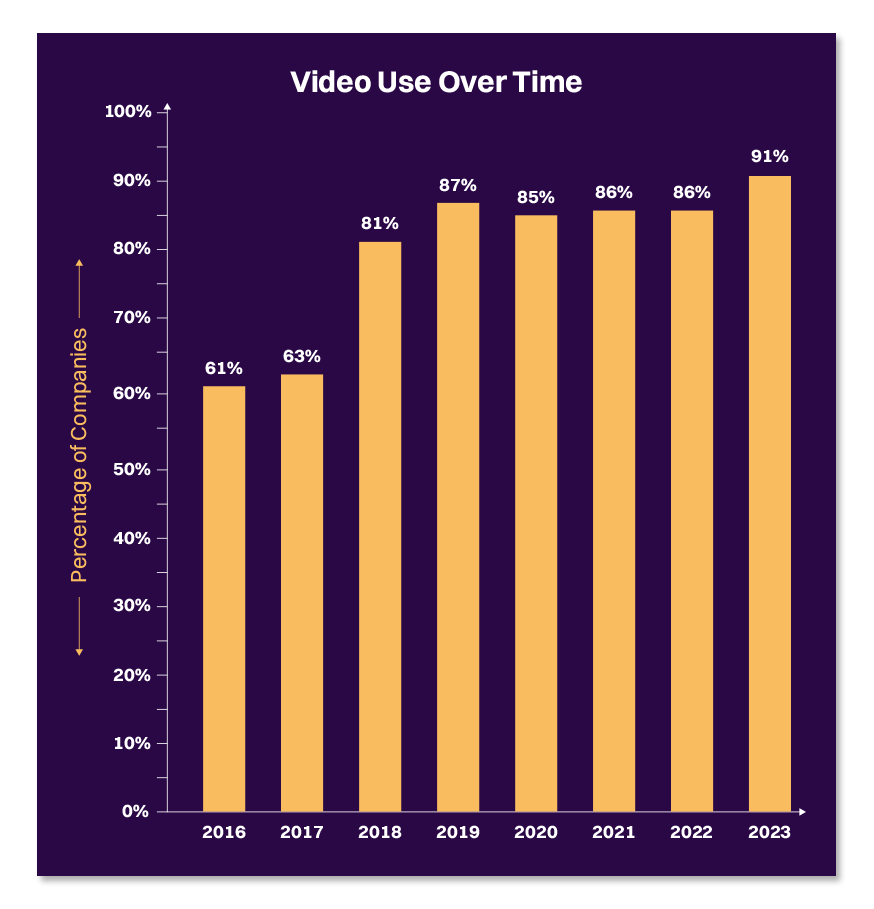
To maximize the impact of your video content's impact, distributing it across various platforms is essential. It includes the following:
- Embedding videos on your website
- Sharing them on social media channels
- Incorporating them into email campaigns
By leveraging these distribution channels, you can expand your reach, increase engagement, and capture the attention of potential leads.
Here are some tips and best practices for creating and distributing video content effectively:
- Focus on Storytelling: Craft compelling narratives that resonate with your target audience, addressing their pain points and offering solutions. Engaging stories help create an emotional connection and enhance the impact of your message.
- Keep it Concise and Engaging: Attention spans are shorter in the digital age. So aim for brief clips that get straight to the point. Capture your viewers' attention within the first few seconds and maintain their interest throughout the video.
- Optimize for Mobile: As mobile usage rises, ensure your videos are optimized for mobile viewing. Use captions or subtitles to make your content accessible. Plus, consider vertical or square video formats for a better mobile experience.
- Incorporate CTAs: Guide viewers to take the next step by including clear and compelling CTAs within your videos. Use CTAs to drive lead generation and conversions by:
- Directing viewers to a landing page
- Encouraging them to subscribe to your channel
- Inviting them to contact your sales team
7. Utilize Content Syndication
89% of marketers find that influencer marketing ROI is comparable to or better than other marketing channels.
You can tap into its potential to drive lead generation and business growth by strategically incorporating influencer marketing.
In fact, it can significantly impact your:Content syndication is a powerful strategy for B2B marketers to:
- Expand their reach
- Amplify their message
- Generate targeted leads
By partnering with industry publications or relevant 3rd-party platforms, you can distribute your content to a broader audience and increase brand visibility.
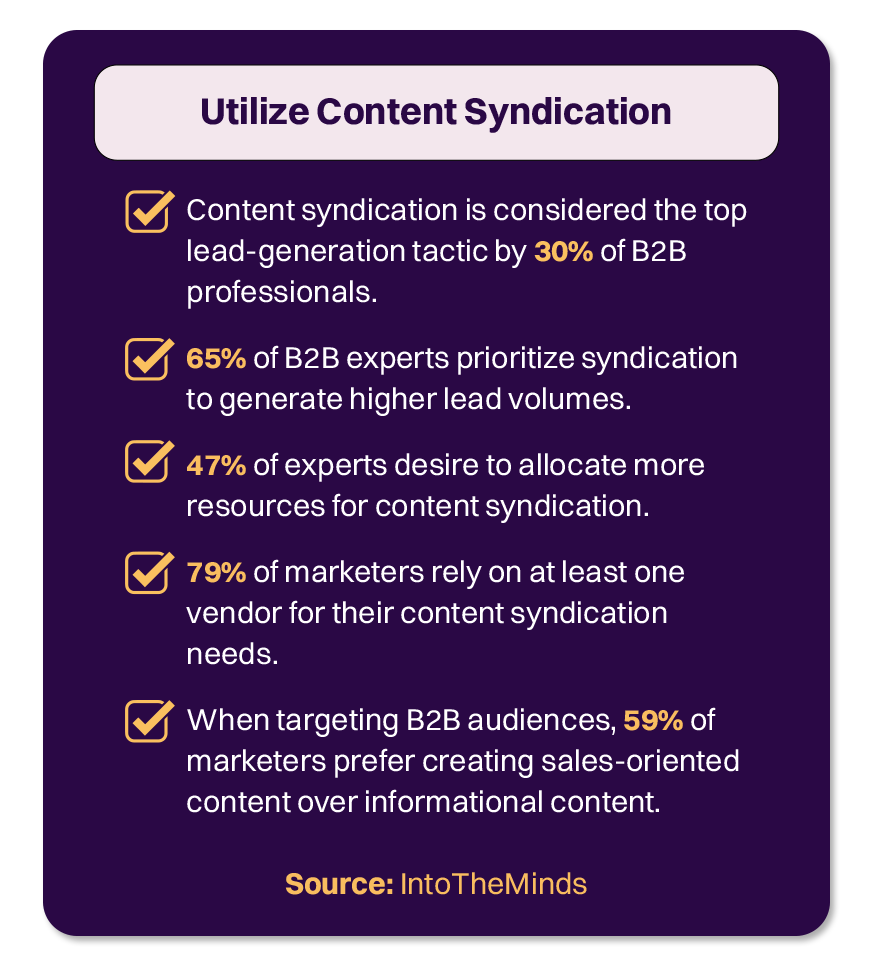
NOTE: To effectively utilize content syndication, you must drive traffic back to your website or gated content. Plus, place your content on reputable platforms. Thus, you’ll attract qualified leads interested in your offerings.
Here are some tips and best practices for effectively utilizing content syndication:
- Choose the Right Syndication Partners: Identify industry publications or 3rd-party platforms with a solid readership base that aligns with your target audience. Look for partners with relevant content categories and a reputation for delivering quality content.
- Ensure Proper Attribution and Linking: When syndicating your content, ensure it is appropriately attributed to your brand and includes links back to your website or landing pages. It helps drive traffic, build brand credibility, and generate leads.
8. Incorporate Influencer Marketing
- Reach
- Credibility
- Lead generation efforts
By collaborating with industry influencers or thought leaders, you can tap into their expertise and audience to amplify your brand's visibility and trust. Here are some insights:
- Collaboration and Co-creation: Partnering with influencers allows you to co-create content or secure endorsements that resonate with your target audience. It helps expand your reach and enhance your brand's credibility.
- Leveraging the Influencer's Network: When you work with influencers, you gain access to their network of followers and subscribers. By leveraging their influence, you can generate quality leads and foster trust among their engaged audience.
- Identifying and Approaching Influencers: To identify suitable influencers in your industry, consider their:
- Relevance
- Reach
- Engagement
- Alignment with your brand values
When approaching influencers, personalize your pitch and emphasize the mutual benefits of the collaboration.
- Measuring the Impact: Track metrics such as engagement, reach, website traffic, and conversions attributed to influencer campaigns. This data will help you assess the effectiveness and ROI of your influencer marketing initiatives.
- Building Long-term Relationships: Focus on creating mutually beneficial partnerships. Provide value to the influencers by:
- Sharing their content
- Featuring them in your campaigns
- Offering exclusive opportunities
Nurture these relationships to ensure ongoing collaboration and maximize the benefits for both parties.
9. Harness Social Proof and User-Generated Content
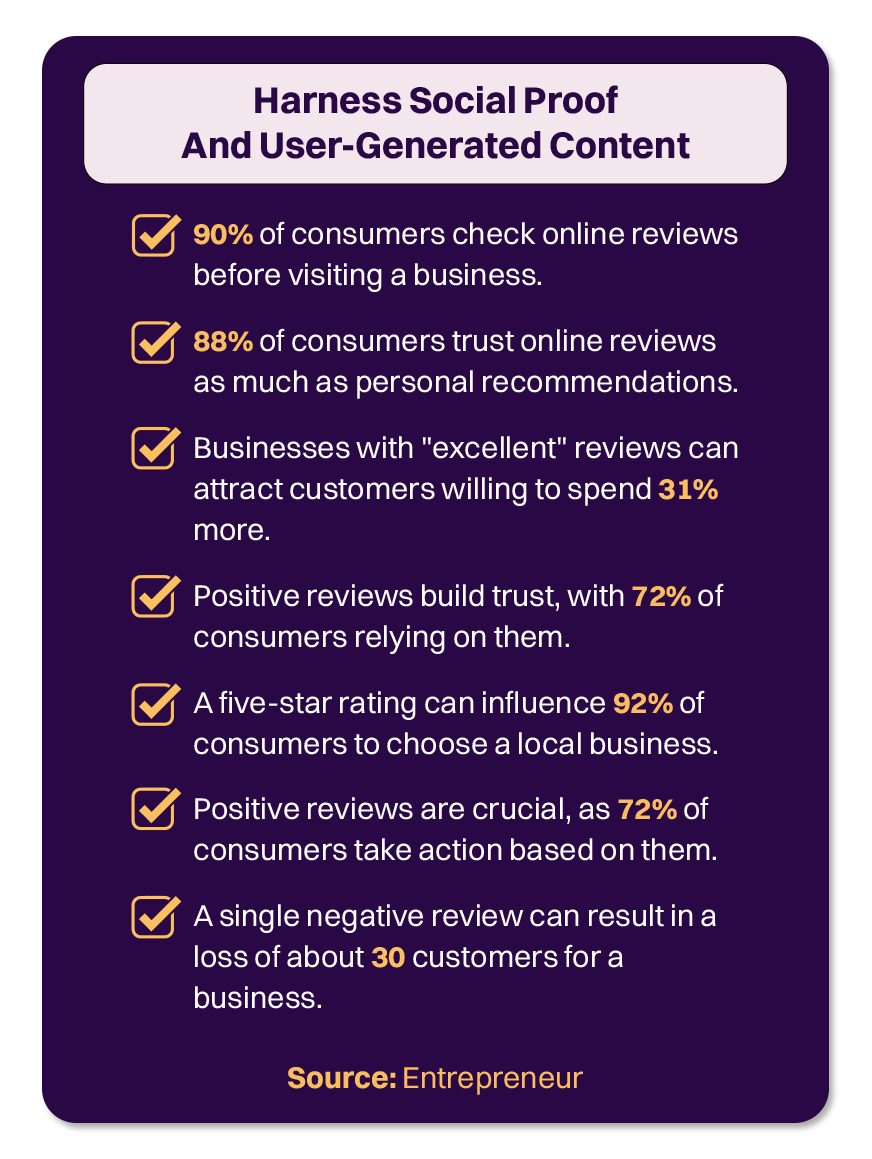
By harnessing social proof and User-Generated Content (UGC), you can leverage the power of positive customer experiences to influence and convert leads.
Here's how you can utilize these strategies:
- Encouraging Testimonials and UGC: Reach out to satisfied customers and request testimonials, case studies, or UGC highlighting their favorable experiences with your products or services.
This content serves as social proof and demonstrates the value and quality of your offerings.
- Leveraging Social Proof: Display the testimonials, case studies, or UGC prominently on your website, landing pages, and marketing materials.
By showcasing real experiences and positive customer feedback, you can instill trust in potential leads and increase their confidence in choosing your business.
By incorporating these strategies into your lead generation efforts, you can:
- Establish credibility
- Overcome skepticism
- Foster trust
– ultimately driving more conversions and business growth.
10. Always Follow The Content Marketing Funnel
The Content Marketing Funnel is a strategic framework designed to align your content creation with the various stages of the buyer's journey.
This funnel consists of three primary stages:
- Top of the Funnel (ToFu – Awareness)
- Middle of the Funnel (MoFu – Consideration)
- Bottom of the Funnel (BoFu – Decision)
By tailoring your content to each stage, you can effectively attract, engage, and convert leads. Here’s how:
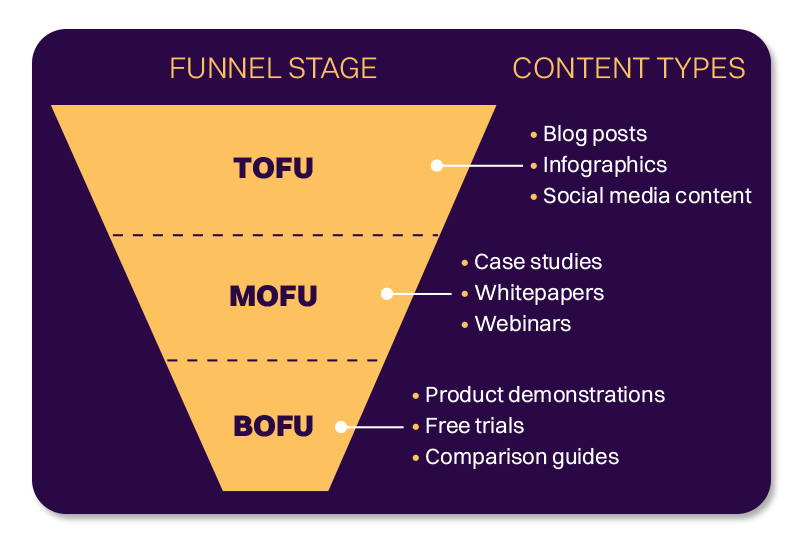
- ToFu: Focus on educational and informative content such as blog posts, infographics, and social media content. These content types generate awareness and establish your brand as a reliable source of information.
- MoFu: Provide more comprehensive content like case studies, whitepapers, and webinars. Such resources showcase your expertise and address specific needs. As such, they help prospects evaluate potential solutions and consider your offerings.
- BoFu: Offer content that highlights the unique value of your products or services. It can include product demonstrations, free trials, and comparison guides – assisting prospects in making informed purchase decisions.
By leveraging the Content Marketing Funnel, you can:
- Tailor your outbound content to different stages of the buyer's journey
- Attract qualified leads
- Nurture them with relevant information
- Drive conversions in your B2B pipeline
11. Implement a Strategic Guest Blogging Approach
Businesses that engage in guest blogging experience:
- 55% more visitors
- 97% more inbound links
- 434% more indexed pages
Implementing a strategic guest blogging approach involves writing and publishing content on external websites or blogs. It helps reach a wider audience and establish thought leadership.
You can do this by:
- Identifying relevant platforms
- Pitching valuable content ideas
- Collaborating with the host sites
Guest blogging expands your reach and enhances brand visibility and credibility among the target audience.
Now, when implementing a strategic guest blogging approach, consider the following best practices and tips:
- Research and identify reputable and relevant websites or blogs in your industry that accept guest contributions.
- Study each platform's guidelines and content requirements to ensure your content aligns with its audience and style.
- Craft high-quality, valuable content with unique insights, actionable tips, and thought-provoking perspectives.
- Focus on building relationships with the host site by engaging with their existing content and audience.
- Include relevant backlinks to your website or landing pages within the guest post to drive traffic and enhance SEO.
- Promote your guest blog post through your channels, such as social media, newsletters, and email campaigns.
- Monitor and respond to comments and engagement on the guest post to foster further discussion and engagement.
- Keep track of the performance of your guest blog posts by analyzing metrics like traffic, engagement, and conversions.
- Continuously refine your guest blogging strategy based on feedback, insights, and results to optimize your impact and reach.
12. Employ the Content Cluster Model
The Content Cluster Model is a strategic approach to organizing and interlinking related content on your website. It involves the following steps:
- Creating a pillar piece of content that serves as the central topic.
- Developing multiple supporting articles or blog posts around that topic.
- Interlinking these pieces to create a network of content that provides comprehensive information to your audience.
As such, it boosts your website's visibility in search engine results.
Here’s an example:
| Pillar Content (Central Topic) | Supporting Articles/Blog Posts |
| Topic: "Digital Marketing Trends" |
Article 1: "Top Social Media Trends for 2023" Article 2: "Emerging SEO Strategies" Article 3: "Content Marketing Best Practices" Article 4: "Email Marketing Innovations" |
This model helps in:
- Establishing topical authority
- Improving user experience
- Driving organic traffic
By grouping related content, you enhance the overall value of your website and make it easier for search engines to understand and rank your content.
In addition, the Content Cluster Model allows you to:
- Target specific keywords
- Answer diverse user queries
- Provide a cohesive user experience
Next, to employ the Content Cluster Model effectively, follow these best practices:
- Conduct keyword research to identify relevant topics and subtopics within your industry.
- Create a pillar piece of content that covers a broad topic comprehensively.
- Develop supporting articles or blog posts that dive deeper into specific subtopics related to the pillar content.
- Interlink the content pieces using anchor text to create a solid internal linking structure.
- Optimize each piece of content for relevant keywords and provide valuable, informative, and engaging content.
- Promote and share your content across various channels to increase visibility and attract organic traffic.
- Regularly update and expand your content cluster to ensure relevance and freshness.
Employing the Content Cluster Model can enhance your website's visibility, improve user engagement, and establish your brand as a reliable source of information in your industry.
The Way Forward
The key to successful B2B lead generation is creating the right content for your buyer personas. Focus on how your content can address their pain points, simplify their purchasing decisions, and make their lives easier. Then, you can significantly enhance your chances of converting more B2B leads. Prioritizing your audience and their needs is crucial, delivering valuable content that establishes your brand as a trusted resource.
At Revnew, we understand the power of content marketing in driving B2B lead generation. Our team of experts can help you develop a tailored content strategy that resonates with your target audience, attracts qualified leads, and converts them into loyal customers.
Don't underestimate the impact of content marketing on your B2B success. Partner with Revnew and unlock the full potential of your content to fuel your business growth.




